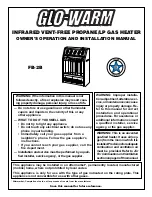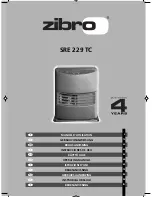
Refer to Mounting/Installation Diagrams on
page one and install as follows (new install):
1. Engine must be off and cool to touch.
2. Apply motor oil to o-rings on UNF/SAE inlet/
outlet fittings.
3. Thread fittings into appropriate fuel ports and
tighten snugly. Plug unused ports (if any) with
port plugs and tighten snugly.
4. Mount filter vertically in a protected area
away from flying debris and heat sources.
Maintain at least 4.0” (10.2 cm) of clearance
below filter for draining water and servicing
filter.
5. Attach fuel lines to filter port fittings. Avoid
tight bends and rubbing areas when routing
hose.
6. Connect water probe and heater wires, if
equipped.
7. Proceed to ‘Priming’ section.
Priming
1. Use a 1˝ open-end wrench to loosen vent
plug and bleed trapped air. Prime filter
by operating hand primer pump until fuel
spills out of vent port.
2. Close vent plug snugly. Or use a 1˝ open-
end wrench to tighten the vent plug.
3. Verify all other connections are tight.
4. Start engine and check for leaks. Correct
as necessary with engine off.
Service
Filter replacement frequency is determined
by contamination level in fuels. Fuel flow to
engine becomes restricted as filter gradually
plugs with contaminants, resulting in
noticeable power loss and/or hard starting.
As a guideline, change filter every 500
hours, 10,000 miles, every other oil change,
annually, or at first indication of power
loss, whichever occurs first.
Always carry
extra replacement filters as one tankful of
excessively dirty fuel can quickly plug a
filter.
1. Engine must be off and cool to touch.
2. Close all fuel valves, if applicable, to make
sure excess fuel does not spill during
servicing.
3. Disconnect water probe and heater
connectors, if equipped.
4. Open vent plug on mounting head.
5. Drain unit of fuel, into a suitable container,
by turning drain on bottom of bowl.
6. Remove bowl and filter. Dispose of filter
properly. Bowl is reusable.
7. Lubricate new filter seals with motor oil or
clean fuel and install with new filter.
Installation Guidelines
8. Re-install bowl and tighten snugly by
hand or using a bowl wrench.
9. Connect water probe and heater
connectors, if equipped.
10. Open all fuel valves, if applicable.
11.
Proceed to ‘Priming’ section.
Draining the Bowl
Water is heavier than fuel and will settle to
bottom of the bowl and appear different
in color if collected in a clear jar. In high
humidity environments, check bowl
frequently (daily if a poor fuel source is
suspected). 4400 Series bowls are equipped
with a water sensor probe and will alert
operator of a high water condition in the
filter.
1. Make sure engine is off and cool to touch.
2. Open vent plug using a 1” wrench.
3. Drain water from filter by opening self-
venting drain. Close as soon as all water
has evacuated.
If drain is open too long, the entire filter
may drain completely of water and fuel.
4. Follow ‘Priming’ section.
Troubleshooting
If filter fails to hold prime, first check vent
plug, drain valve, fittings, head, filter, and
bowl are properly tightened. Next, check
fuel line connections and verify they are free
of pinches or unnecessary bends and check
to see if fuel tank strainer (or pick-up tube) is
clogged. If problems persist and filter is new,
call Technical Support at 800-344-3286,
7 AM to 4 PM, Pacific
Time.
In-Bowl Heater
Note: Electric heaters must not be used
in gasoline applications.
The in-bowl heater is a cold weather
starting aid with an internal automatic
thermostat that turns the heater on
if fuel temperature drops below 45°F
(7°C). Heat is supplied just below the
filter to melt wax crystals and allow fuel
to efficiently pass through. The heater
will automatically turn off at about 75°F
(24°C). The heater is available in 12
vdc (200 watt) or 24 vdc (200 watt).
The heater is operated by turning on
the ignition switch for a minimum of 5
minutes prior to starting the engine.
Customer Supplied Items
1. Due to heater power demand, 21
amps for 12 vdc and 11 amps
for 24 vdc, an additional relay is
recommended for safest method of
installation. Racor offers two relay
kits (sold separately), RK 11861 for
12 vdc systems or RK 11862 for
24 vdc systems. These kits include
an in-line fuse holder (and fuse).
2. An on-off toggle switch may be used
to control power to heater relay. This
allows the operator to cut power
to heater relay during summer or
when servicing the filter in cold
environments.
3. All wires should be 14 AWG
(American Wire Gauge), minimum.
Installation
1. Either heater wire may be used for Hot
(+) or Ground (-).
2. Wire/terminal connections should be
soldered and crimped.
3. Run wires in protected locations.
Avoid hot surfaces and places that
could pinch or rub on the wires.
Heater connector is
a Sebro 4661958.
Customer
supplied
connector
* Use a 15 amp fuse and resistor with 24 vdc systems.
Battery
-
+
Ignition
Switch
*
fuse
*
resistor
Relay
C4 B2
A5 E3
Fuse Box
1 amp
fuse
Manual on-off
switch (optional)
Maximum power requirement for in-bowl heater option: 12vdc (200W) = 16.6 amps,
24vdc (200W) = 8.3 amps. Use a Racor heater relay, if needed—sold separately.




















